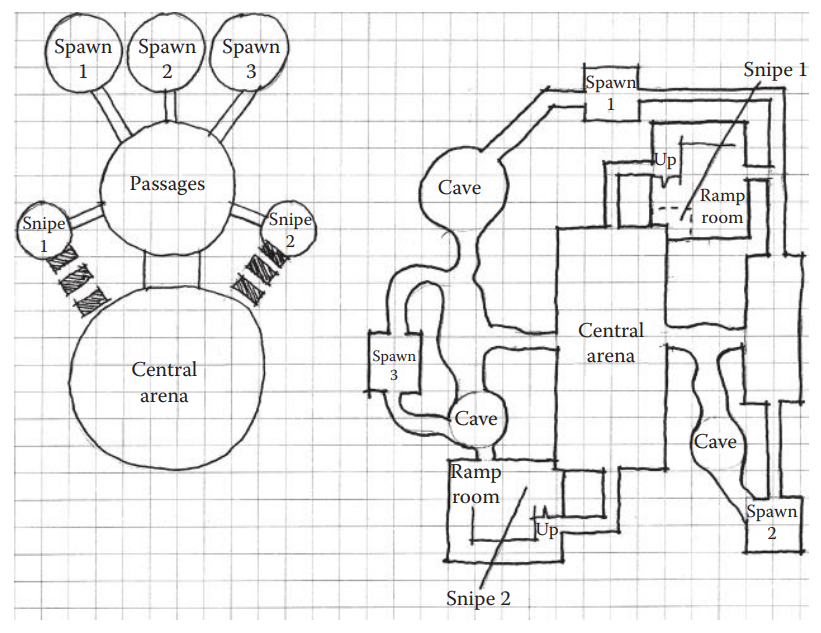Proximity Diagram
also known as:
Classification
- #method
- #medium/graph #medium/visual #medium/diagram
- #roles/designer
- #used-by/designer #used-by/artist #used-by/engineers
- #tools/digital #tools/non-digital
Intent
- Similar to Molecule Diagrams.
- Structuring the level using a detailed, language-coded approach.
- Providing a spatial overview of the level.
- Determining the placement of level objects, gates, encounters, gameplay beats, and story points in a spatial context.
- Establishing a dynamic relationship between narrative and space.
- Coordinating space requirements alongside space allocation.
Problem
- In contrast to Molecule Diagrams, you specifically want to describe spatial relationships, e.g. the size of the rooms/game spaces or the connection of specific rooms
- Establishing connections between game spaces within the level based on how important their connection is.
Solution Approach
- Create a Molecule Diagram but convey additional meaning through node size and connections.
- Utilize all the principles of the Molecule Diagram while enhancing its meaning.
Application
Input
- Decisions regarding which game spaces are present in the level and require additional information.
- Pen and paper or digital tools.
- Knowledge of graph theory.
Application
-
Construct a Molecule Diagram.
-
Adjust the sizes of nodes based on:
- Spatial metrics, such as larger representations for rooms of 50m² compared to rooms of 30m².
- The significance of the game space within the level.
-
Modify the thickness of connections between nodes to reflect their importance.
- Utilize different line types to signify accessibility between spaces (normal lines) or one-way visibility from one space to another (dashed lines). Apply creativity and only depict what you wish to communicate.
-
Apply the tips and principles from Molecule Diagrams.
Output
When to Use It
- In the planning and designing phases.
- When you want to imbue a Molecule Diagram with additional layers of meaning.
Relevant Roles Using This Model
Relevance in the Following Processes
- Gamespace Prototyping
- Planning and designing phases of Game Development
- Combat Design
Applicability
- Similar to the Molecule Diagram, with added details.
Pros and Cons
- Similar to the Molecule Diagram.
Relation with Other Methods
- Closely related to the Molecule Diagram.
- May lead to Drawing a Map as a subsequent step after constructing the diagram.
Examples
- One example of transferring a Proximity Diagram to a Map
 (Source: Totten 2019 - An Architectural Approach of Level Design, p.133)
(Source: Totten 2019 - An Architectural Approach of Level Design, p.133)
Relevant Tools
- See Molecule Diagram
Relevant Literature
Totten 2019 - An Architectural Approach of Level Design
The Metrics of Space - Molecule Design
...
Notes mentioning this note
Molecule Diagram
also known as:
Classification
#method
#medium/diagram
#medium/graph
#medium/visual
#tools/non-digital
#tools/digital
#process/planning
#process/designing
#roles/designer
#roles/engineers
#roles/artists